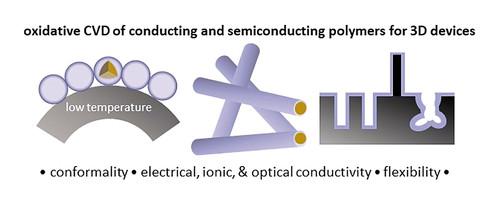Three-Dimensional (3D) Device Architectures Enabled by Oxidative Chemical Vapor Deposition (oCVD)
引用次数: 0
Abstract
For fabricating devices with three-dimensional (3D) architectures, oxidative Chemical Vapor Deposition (oCVD) offers conformal nanocoatings of polymers with designable composition. Pure, uniform and pinhole-free oCVD layers are achievable with sub-10 nm thickness and sub-1 nm roughness. The low substrate temperature used for oCVD, allows direct deposition onto the thermally sensitive substrates desired for flexible and wearable devices. The oCVD polymers can graft to the underlying material. The covalent chemical bonds to the substrate create a robust interface that prevents delamination during the subsequent device fabrication steps and exposure to the environmental conditions of device operation. Both electrically conducting and semiconducting polymers have been synthesized by oCVD. Small ions act as dopants. The oCVD process allows for systematic tuning of electrical, optical, thermal, and ionic transport properties. Copolymerization with oCVD can incorporate specific organic functional groups into the resulting conjugated organic materials. This short review highlights recent examples of using oCVD polymer to fabricate organic and hybrid organic-inorganic devices. These optoelectronic, electrochemical, and sensing devices utilize 3D architectures made possible by the conformal nature of the oCVD polymers. Table of Contents: 1 Introduction 2 oCVD Chemistry and Process 3 Optoelectronic Devices 4 Electrochemical Devices 5 Sensing Devices 6 Conclusion

氧化化学气相沉积(oCVD)实现三维(3D)器件架构
为了制造具有三维(3D)结构的器件,氧化化学气相沉积(oCVD)提供了具有可设计成分的聚合物的适形纳米涂层。在10 nm以下的厚度和1 nm以下的粗糙度下,可以实现纯净、均匀和无针孔的oCVD层。用于oCVD的衬底温度低,允许直接沉积到柔性和可穿戴设备所需的热敏衬底上。oCVD聚合物可以接枝到底层材料上。与衬底的共价化学键创建了一个坚固的界面,防止在随后的设备制造步骤中分层和暴露在设备操作的环境条件下。用光相沉积法合成了导电聚合物和半导体聚合物。小离子充当掺杂剂。oCVD工艺允许系统地调整电学、光学、热学和离子传输性质。用oCVD共聚可以将特定的有机官能团纳入所得的共轭有机材料中。这篇简短的综述重点介绍了最近使用oCVD聚合物制造有机和有机-无机杂化器件的例子。这些光电、电化学和传感设备利用oCVD聚合物的共形特性使3D结构成为可能。目录:1绪论2 oCVD化学与工艺3光电器件4电化学器件5传感器件6结论
本文章由计算机程序翻译,如有差异,请以英文原文为准。
求助全文
约1分钟内获得全文
求助全文

 求助内容:
求助内容: 应助结果提醒方式:
应助结果提醒方式:


